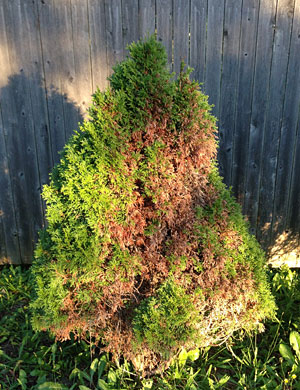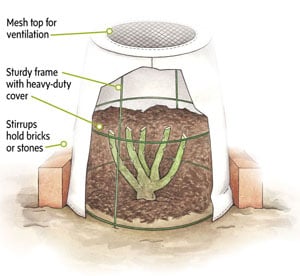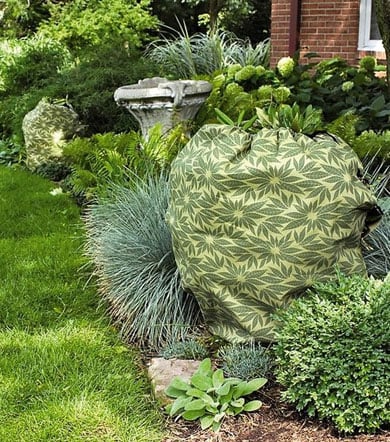How To Protect Your Garden & Landscaping From Winter Weather
Ice and snow and wind, oh my! Prevent winter storm damage to garden plants
If extreme winter weather has ever taken a toll on your landscape plants, you aren't alone. Every spring, gardeners in regions hit by a tough winter discover the damage it can cause to trees and shrubs. Fortunately, you can take steps to prepare your garden for winter to wreak its havoc.
How Does Winter Weather Impact Gardens and Landscaping?

Winterburn on an evergreen shrub
Cold Temps
Most plants, if planted in the correct growing zone, can handle cold temperatures pretty well. However, early cold spells can damage plant tissues that haven't had a chance to harden off for the winter. Sudden midwinter thaws can also "fool" plants into breaking dormancy too early, and the tender new buds may be killed by the next cold snap. Alternating freeze/thaw cycles can heave new plants out of the ground, leaving roots exposed to drying wind and sun.
Sunscald
Sunscald occurs when bright winter sun heats up dark tree bark, which can freeze and crack when temperatures drop quickly at sunset. The damage may not show until the next spring or summer when new growth occurs, and further problems from insect and disease entry at the damaged site may affect the tree. Young trees and species with naturally thin bark are especially prone — think ash, beech, linden, honey locust, and fruit trees.
Winterburn
Dry winds and winter sun can dry out or "burn" conifer needles and broadleaf evergreen foliage, which continue to transpire (give off water vapor) during winter. Frozen soil means plant roots can't take up water to replace the moisture lost from evaporation and transpiration.
Hungry Wildlife
Deer, mice, rabbits and other animals gnaw bark and browse leaves and twigs when other food becomes scarce during long, cold winters.
Heavy Snow and Ice
Snow cover is usually good for plants, and a layer of snow provides moisture and helps insulate the soil and roots from fluctuating temperatures. However sudden dumps of wet snow or ice can squish shrubs and snap tree limbs.
How to Prepare the Garden for Winter
Healthy plants are more likely to get through winter unscathed. A plant that has struggled during the growing season, whether due to insufficient sunlight, water or nutrients, or heavy damage from insects or disease, will enter winter in a vulnerable state.
Tasks to complete in autumn:
- Water plants thoroughly throughout fall until the ground freezes; make sure the water penetrates 12" to 18" deep to reach the root zone.
- Drain water from hoses before storing.
- Empty and store terracotta planters and pots indoors — they tend to crack in freezing temperatures.
- Wooden elevated raised beds can be left outside. Consider adding a layer of compost and a protective canvas cover.
Tasks to stop by autumn:
- Don't prune after midsummer. Pruning stimulates new growth during a time when plants should be hardening off existing growth.
- Stop fertilizing plants by the start of fall — again, winter is a time for plants to go dormant and a sudden surge of nutrients can prevent this from occuring.
Winter Garden Prep By Plant Type
Perennials
Most perennials die back to the ground in the winter and provided they are growing in the correct zone, will overwinter just fine without too much help. Plants prone to disease or powdery mildew (bee balm) can be pruned down in the fall to prevent overwintering infectious material, however native perennials with large seedheads (coneflower, goldenrod, rudbeckia) can be left standing for birds to feast on.
Roses
Water roses regularly through the fall. After the first frost, remove any dead canes and mulch plants with compost or leaves to just above the swollen point where the stem joins the rootstock. In areas where winter temperatures are severe, protect tender roses with a sturdy wire shelter filled with mulch, or, better yet, use a Rosy Cozy Cone.
Deciduous Trees and Shrubs
Deciduous shrubs and trees — those that lose their leaves in autumn — have adapted to life in cold-winter climates by going dormant. Many of these techniques are designed to ensure that plants enter dormancy before the coldest weather arrives, and remain dormant until spring.
Mature trees and shrubs that are hardy in your region need no extra protection. However, young and newly planted trees and shrubs benefit from some extra TLC.
1. Keep Watering New Plants
Because plant roots may not have ventured very far into the native soil, it's especially important to water newly planted trees and shrubs thoroughly into fall, until the ground freezes.
2. Insulate Soil & Roots with Mulch
Once the ground is frozen, apply a 3" to 4" layer of insulating mulch, such as bark mulch or pine straw, around the base of the plant. This helps insulate the soil so it stays frozen and helps prevent heaving. Keep the mulch several inches away from the trunk to prevent rot and discourage rodent chewing.
3. Guard Against Hungry Critters
Tender young bark is easily damaged by gnawing mice and rabbits. Protect the trunks of young trees — especially fruit trees — with tree guards made of plastic or wire.
4. Protect Bark from Sunscald
The bark of young trees is also susceptible to sunscald (see above). Wrap the lower trunk with light-colored paper tree wrap to prevent thin bark from cracking and peeling. A diluted solution of white latex paint can also be applied to the south side of the tree bark, however some gardeners prefer a more temporary solution.
Conifers and Broadleaf Evergreens
Trees and shrubs that remain green — conifers and broadleaf evergreens, such as rhododendrons — slow their growth but never go fully dormant. It's especially important that they have a ready supply of water whenever the ground isn't frozen.
1. Shield From Winter Winds
Drying winter winds are especially damaging to evergreens. In exposed, windy areas, erecting a windbreak helps prevent damage, as can wrapping shrubs with burlap or easy-to-use shrub wraps.
2. Remove Snow — But Not Ice
If branches are bending under the weight of a heavy snowfall, gently remove some of the snow. However, don't try to remove ice after an ice storm; you're likely to cause more harm than good.
3. Protect Against Salt Spray
Some evergreens, notably white pines, are susceptible to damage by road salt sprayed onto branches by passing snowplows. In spring, you'll see brown needles on the road-facing side of the tree. There is little you can do for huge mature trees, however you can protect small hedges and shrubs with burlap or shrub wraps. Be sure to wrap shrubs loosely so plenty of air and moisture can pass through.
After all your hard work planting and tending to your garden during the growing season, the damage that a single winter storm may bring can be devastating. We hope these simple tips, tools, and techniques can help prevent your plants (and your heart) from breaking, and set you up for another successful season of hardy growth!
Print this Article:
Get the Dirt
Stay up to date on new articles and advice. Please fill out the information below.



